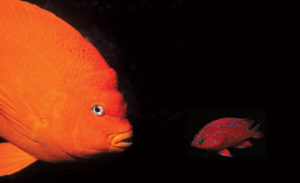Newborns of many species — horses, kittens and elephants for example — look like miniature versions of their parents, although they are universally a lot cuter. It is, of course, a great advantage to be cute as cuteness might help a mother bond to its young and lessen the odds of animal parents abandoning their young should they misbehave. Other animals start out looking nothing like their parents and may go through one or more developmental phases before assuming the final “you look just like your old man” adult phase. A good example of this is the hydroid. California hydrocoral have a free-swimming larval phase, a free-swimming medusa (jelly-like) phase and a sedentary polyp phase. During each phase the hydroid appears totally different from what it looked like in the previous phase. Many fish species also go through developmental phases, although they are not quite as dissimilar as what many invertebrates experience. Many have a pelagic, larval phase, a juvenile phase with coloration and patterns that are quite different from their parents, and a terminal adult phase, which is often how they will appear throughout the rest of their lives.
Inhabitants of tropical waters often undergo dramatic color changes and changes in color patterns as they mature from juvenile to adult. Wrasses and angelfish are conspicuous examples.
There are many California fishes that also change color and patterning as they develop, and some do it very dramatically. This article examines the life cycle of three of California’s notable quick-change artists.
Garibaldi
The garibaldi is the State of California marine fish and is a member of the damselfish family. Like all damselfish, garibaldis are extremely territorial, and aggressively defend their nests and territory. They are the largest member of the damselfish family. If garibaldis grew larger than their adult size of about 12 to 15 inches, it’s likely none of us would ever get in the water.
Adult garibaldis are one of the most ostentatious fish on California reefs, sporting a deep orange color. The male does most of the heavy lifting when it comes to rearing the next generation. The male will lay claim to a flat rock with a nearby hole to hide in, where he will spend the rest of his life. He will work tirelessly to trim away the algae to a “just right” length and hope the garden is spotless enough to attract a female. The successful nest builder will attract not just one, but several (and sometimes as many as 20) females to lay their eggs in his nest. Seems that keeping a neat and tidy property has its advantages. He is the sole guardian of the nest.
The male aggressively protects the nest, but when the eggs hatch the young larvae are planktonic and are on their own. Some months later the larvae settle on a reef and adopt their juvenile coloration, which is a deep, iridescent blue with patches of orange. Over time the blue area shrinks as the orange patches grow to yield a mostly orange fish with blue spots. In the terminal, adult phase, the blue patches disappear. This is one of the most remarkable transformations among fishes, and shows off two of the most brightly colored individuals inhabiting California reefs.
Rockfish
Rockfish are the most common fish on California’s reefs and are members of the scorpionfish family. All scorpionfish, including rockfish, have venom-filled spines, but the venom in our local rockfish pales in comparison to fish found in tropical waters. There are some 60 species of rockfish on the West Coast and all are members of the genus Sebastes, which means “magnificent.” This is an appropriate name since so many of our local rockfish are magnificently colored.
Although quite similar in overall shape, each species has developed different behavioral characteristics, food preferences and coloration. For instance blue rockfish are mostly found swimming in open water near kelp beds. Blues are opportunistic feeders and will eat whatever drifts past them. They are particularly fond of jellies, crustaceans and tunicates. At the same time treefish and vermilion rockfish prefer to inhabit the bottom around rocky areas and principally feed on at mollusks, crustaceans, and small fish. Kelp rockfish will feed on planktonic creatures and do not swim very far from the kelp canopy. This specialization of preferred food and habitat allows a great number and variety of similar fish to coexist on a single reef without directly competing with each other.
Rockfish bear live young that are just under a quarter-inch in size when they are released into the water. At that time they are planktonic and drift with the currents for several months. They then develop into their juvenile forms and seek shelter in near-shore rocky areas and kelp beds. Sometime later (depending on temperature and food availability) they develop into the terminal, adult form.
Of all the rockfish the kelp rockfish is the least magnificent in color. The official description is “tan to brown with no distinctive markings.” The juvenile phase is much more flamboyant with alternating white and reddish-brown, vertical bars, with the fourth bar having a distinctive “Y” shape.
With its flamboyant red coloring as an adult, the vermilion rockfish certainly counts among the most magnificent of the rockfish. Juveniles have a more subdued, mottled red and white coloration but are still quite attractive.
Adult treefish are adorned with yellow and black bars, as are their juvenile phase. However, the adults sport dull and weathered colors, in contrast to the crisp and vivid colors of the juveniles.
California Sheephead
California sheephead undergo some of the most extreme and least predictable transformations of any fish species. Sheephead are among the most important members of the Southern California reef system. They are one of the principal predators of sea urchins, which are the principal predator of giant kelp. The population dynamics between fishes, urchin and kelp are extremely important to determine the size and health of our kelp beds, and the abundance and diversity of other marine life within the kelp community.
Sheephead are carnivores, and feed on mollusks and crustaceans in addition to urchins. Both sexes have large, protruding canine teeth perfect for prying hard-shelled animals from rocks. They also have powerful jaws and sharp teeth for crushing prey. Modified throat bones (a throat plate) enable them to grind shells into small pieces.
Sheephead are broadcast spawners. Males and females simultaneously release sperm and eggs into the water column. Each female releases between 30,000 and 300,000 eggs, and the alpha male works to keep lesser males away from his females during spawning. The fertilized eggs develop into larval fish that drift with the currents. Months later they further develop into juvenile fish and take their place in the kelp forest. These juvenile sheephead have mostly red bodies with a white midbody stripe and black spots on the dorsal, anal, and tail fins. Sheephead are members of the wrasse family, and all wrasses are born female.
As the juveniles grow, they develop into sexually mature females. These have a relatively uniform pink to reddish brown color with a white chin. Then some of the females transform into males. The males grow much larger than the females, have larger canine teeth, reddish orange midbodies, and black heads and rear bodies.
The precise conditions that trigger the change from female to male are only partially understood. Sheephead hang out in groups with one large, dominant alpha male. The male aggressively rules over the females, and his aggressive behavior suppresses the hormonal changes necessary to stimulate sex change. When the dominant male is removed from the group, the largest dominant female transforms into a male and assumes the alpha roll.
If the changes in color during their sexual development were not dramatic enough, many wrasses, including sheephead, also change color at night. As the sun sets female sheephead seek out shelter in the reef, surrounding themselves with a mucus membrane “cocoon” they change color and develop a mottled pattern. Sometimes the change is from pale pink to brown or gray, but sometimes they develop an outrageous, deep pink color. Males don’t seem to change color nearly as routinely as females.
Sheephead were once more common on our Southern California reefs. However, selective fishing of the larger males effectively removed the more successful members of the species. So now there are fewer fish overall, and the transformation from female to male occurs earlier and at a smaller size.
Why the Changes?
So how do these fishes change so dramatically? And what advantage does the adoption of very different phases offer? The answers to these questions are complex and not completely understood.
Many fishes, like the garibaldi example above, are fiercely territorial and will drive away any fish that looks like them. Juveniles that look different, and likely feed on different prey, are not viewed as competitors for food, territory, and mating opportunities. They tend to be tolerated. A juvenile may obtain some advantage in settling in an area near adults of the same species to ensure availability of the proper food and mates when it matures, and may be more successful if it is not viewed as a competitor by the adults.
Color differences may also be useful for fish to discern males from females, and between sexually mature and immature individuals. This adaptation tends to conserve energy. It makes no sense for a male to chase away a receptive female, or drive an immature male away from his territory, or engage in an elaborate mating ritual with an immature female. It is a good guess that the color change that we see in female sheephead at night may function to break up their outline, making them difficult to find in the dark.
Regardless of the precise mechanism of these color changes and the advantages they confer, they provide divers with all sorts of marine identification conundrums. On your next dive, try to identify the various juvenile fishes you see and then see if you can find a mature adult of the same species. This is more challenging than you might imagine.


 Newborns of many species — horses, kittens and elephants for example — look like miniature versions of their parents, although they are universally a lot cuter. It is, of course, a great advantage to be cute as cuteness might help a mother bond to its young and lessen the odds of animal parents abandoning their young should they misbehave. Other animals start out looking nothing like their parents and may go through one or more developmental phases before assuming the final “you look just like your old man” adult phase. A good example of this is the hydroid. California hydrocoral have a free-swimming larval phase, a free-swimming medusa (jelly-like) phase and a sedentary polyp phase. During each phase the hydroid appears totally different from what it looked like in the previous phase. Many fish species also go through developmental phases, although they are not quite as dissimilar as what many invertebrates experience. Many have a pelagic, larval phase, a juvenile phase with coloration and patterns that are quite different from their parents, and a terminal adult phase, which is often how they will appear throughout the rest of their lives.
Newborns of many species — horses, kittens and elephants for example — look like miniature versions of their parents, although they are universally a lot cuter. It is, of course, a great advantage to be cute as cuteness might help a mother bond to its young and lessen the odds of animal parents abandoning their young should they misbehave. Other animals start out looking nothing like their parents and may go through one or more developmental phases before assuming the final “you look just like your old man” adult phase. A good example of this is the hydroid. California hydrocoral have a free-swimming larval phase, a free-swimming medusa (jelly-like) phase and a sedentary polyp phase. During each phase the hydroid appears totally different from what it looked like in the previous phase. Many fish species also go through developmental phases, although they are not quite as dissimilar as what many invertebrates experience. Many have a pelagic, larval phase, a juvenile phase with coloration and patterns that are quite different from their parents, and a terminal adult phase, which is often how they will appear throughout the rest of their lives.






